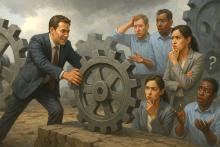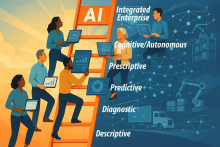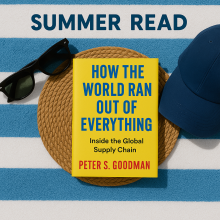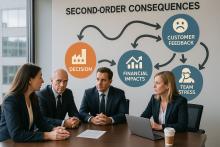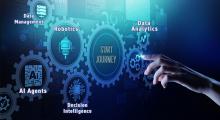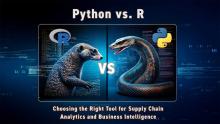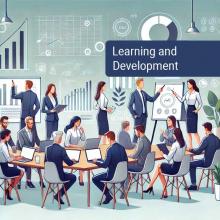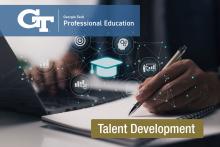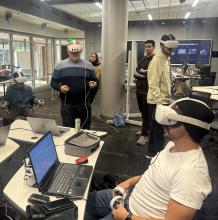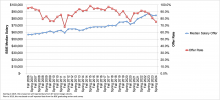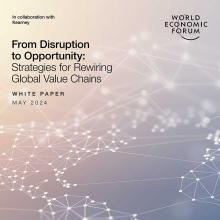Recent Headline Articles
Why Change Management Remains the “Says Easy, Does Hard” Skill Every Supply Chain Leader Must Master
Change management is identified as the most critical skill for supply chain leaders to master, especially amid constant transformations driven by automation, digitalization, and evolving business models. Despite technological advances, 70% of major supply chain transformations fail, primarily due to challenges on the people side rather than technology itself. Effective change leadership significantly improves project success rates, adoption, and time to value.
Less Is More: Communication as the Quiet Differentiator in Supply Chain Leadership
Effective communication is a critical differentiator in supply chain leadership, blending listening, observation, and clear messaging to transform insights into action. This skill is essential for collaboration across complex networks and remains invaluable despite advances in automation and AI.
If I Were Starting My Supply Chain Career Today, Here’s How I’d Learn GenAI
This year has felt like a lifetime in the Generative AI (GenAI) world. Tools, capabilities, and best practices are shifting monthly, sometimes weekly. For supply chain professionals, the message is clear: ongoing development is not optional. Like lean, analytics, or S&OP in prior decades, GenAI proficiency is quickly becoming a differentiator. The question is not if you’ll integrate GenAI into your workflow, but how quickly and effectively.
Don’t Get Left Behind: Climbing the AI Ladder in Your Supply Chain Career
AI has evolved from earlier machine learning in supply chains to now driving real-time analytics across industries, streamlining tasks from content creation to demand planning.
Don’t Outsource Your Thinking: Critical Thinking in the Age of AI and Supply Chain Complexity
In an era dominated by AI and rapid information delivery, critical thinking is more essential than ever—especially for supply chain professionals. While AI tools offer speed and scale, they must be used intentionally to avoid dulling human judgment.
The Human Edge in the Age of AI: What Technology Can’t Replace—And How to Build Your Advantage
As AI transforms the workplace, lasting success will belong to those who sharpen the human edge—judgment, collaboration, adaptability, and leadership—while embracing technology as a partner, not a replacement.
A Summer Read for Supply Chain Learners: 'How the World Ran Out of Everything' by Peter Goodman
A grounded look at what happens when supply chains break — and what it teaches us about how we build them.
A Summer Read for Supply Chain Learners: 'Better' by Atul Gawande
In supply chain management, continuous improvement is achieved through numerous small, thoughtful actions, making Better by Atul Gawande a recommended summer read for its insights on this relentless pursuit.
The Blind Spot in Big Decisions: Why Second-Order Consequences Deserve a Front Row Seat
In the world of strategic decision-making—whether in Supply Chain Management and Engineering or in policy—we tend to focus our energy on the immediate problem in front of us. But in my experience—especially during my time at Coca-Cola and across broader industry engagements—what often gets left out of the room are the second-order effects. These are the unintended consequences that don’t show up in the PowerPoint deck, but show up months or years later on your P&L, in your customer feedback, or in your team’s stress levels.
Emerging Technologies in Supply Chain: A Wake-Up Call for Fast Followers
Today’s supply chain industry is undergoing a rapid transformation, driven by AI, robotics, and data analytics. These innovations are already delivering measurable efficiency gains, and fast followers – companies that quickly adopt proven technologies – must take action or risk falling behind.
Python vs. R: Choosing the Right Tool for Supply Chain Analytics and Business Intelligence
In today's data-driven world, supply chain professionals and business leaders are increasingly required to leverage analytics to drive decision-making. As companies invest in building data capabilities, one critical question emerges: Which programming language is best for supply chain analytics—Python or R?
How Tariffs May Reshape Global Trade and Supply Chains
Professor Alan Erera provides insight into the impact of tariffs on global trade and supply chains by expanding on his earlier article and emphasizing the current challenges faced by businesses adapting to new trade policies.
Intentional Development Planning for Supply Chain Professionals: A Quick Step Guide
The new year provides a natural opportunity to refocus on professional growth. For busy supply chain professionals, development planning can often fall to the bottom of the priority list, especially amidst the daily challenges of managing operations and responding to disruption. Yet, this intentional focus on skill-building is more critical than ever.
The Key to Competing in a Changing World: Talent Development in Supply Chain and Logistics
In the dynamic world of supply chain and logistics, talent development has emerged as a critical differentiator for organizations seeking to stay competitive. As businesses navigate the complexities of global supply chains, disruptive technologies, and shifting market demands, having a skilled and adaptable workforce isn’t just an advantage—it’s a necessity. Moreover, investing in talent development isn’t only about building capability; it’s also a proven strategy for attracting and retaining top talent in a competitive job market.
Innovative Learning in Action: Language Institute Students Pilot Virtual Supply Chain Final Exam at Georgia Tech
Georgia Tech's Supply Chain and Logistics Institute partnered with the Language Institute to Launch a Virtual Supply Chain Final Exam
Risk and Resiliency: Practical Steps for Supply Chain Professionals, Businesses, and Individuals
In today's increasingly volatile world, the frequency of disruptions—whether due to natural disasters, geopolitical events, or supply chain interruptions—has grown. Recent challenges such as hurricanes, port strikes, wildfires, and global disruptions like the Suez Canal blockage, Panama Canal delays, and Red Sea freight issues have proven that the risk of major interruptions to business and personal life is no longer hypothetical. With the probability of a disruption higher than ever, the key question becomes: What prudent, no-regrets steps can individuals, families, and businesses take to assess and mitigate risk?
Predicting the Future of Supply Chains: Learning from the Past to Navigate Uncertainty
In a rapidly evolving global landscape, predicting the future of supply chains is akin to trying to catch lightning in a bottle. By examining past trends and disruptions, we can glean invaluable insights into what the future might hold and how to navigate it effectively. This article, drawing from Chris Gaffney's extensive experience in the beverage industry, explores the inherent challenges of forecasting supply chain trends, reflects on past predictions that didn't pan out, and suggests proactive strategies to stay ahead of the curve.
Staying Current in the World of Supply Chain: My Go-To Resources
People often ask me how I stay up to date with the latest trends and developments in the dynamic world of supply chain management. Given the rapid pace of change in our field, it's essential to leverage a variety of resources to maintain a comprehensive and current understanding. Here, I’d like to share some of the resources I find most effective.
Post BSIE Offer Rate/Salary Survey Summary (Spring 2024)
Post-graduation plans for Spring 2024 ISYE graduates show several trends, including most notably a decline in job offer rates and a heavy shift into analytics. The decline in offers is likely due to the cyclical nature of consulting and reduced tech resources.
Embracing the Future of Supply Chain Management: A Framework for Resilience, Innovation, and Sustainability
The SCL Industry Advisory Board has asked our team to provide a future perspective on Supply Chain evolution, emphasizing the importance of resilience, innovation, and sustainability. Key points include the necessity of resilience and risk management, the strategic implementation of nearshoring, the potential of AI and digital technologies, the importance of talent management, and the integration of sustainability into supply chain strategies.
